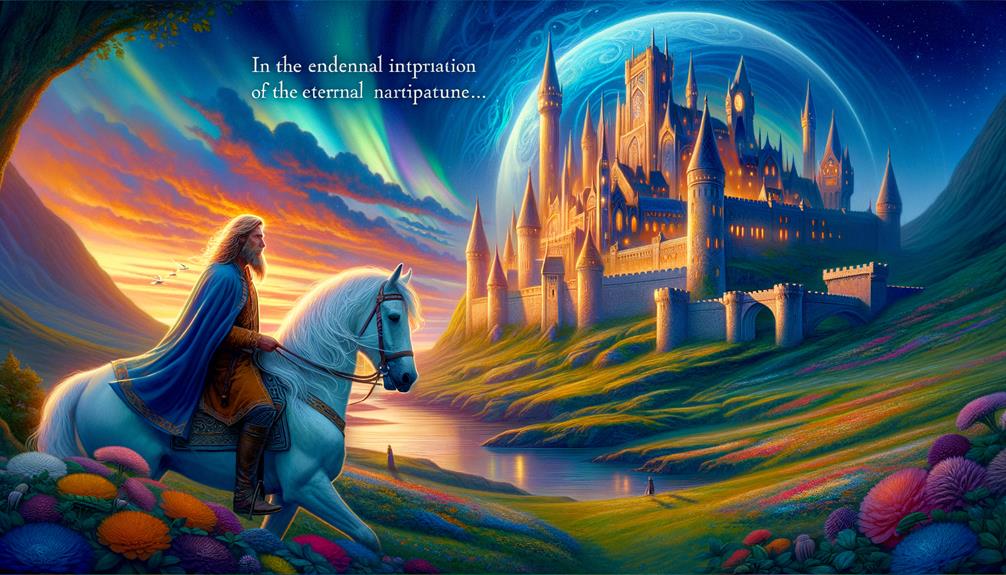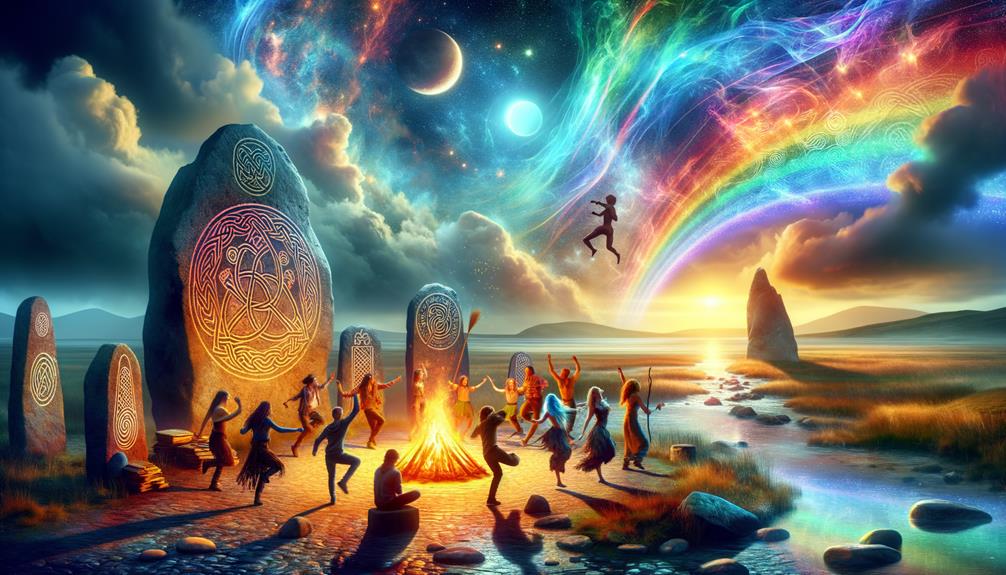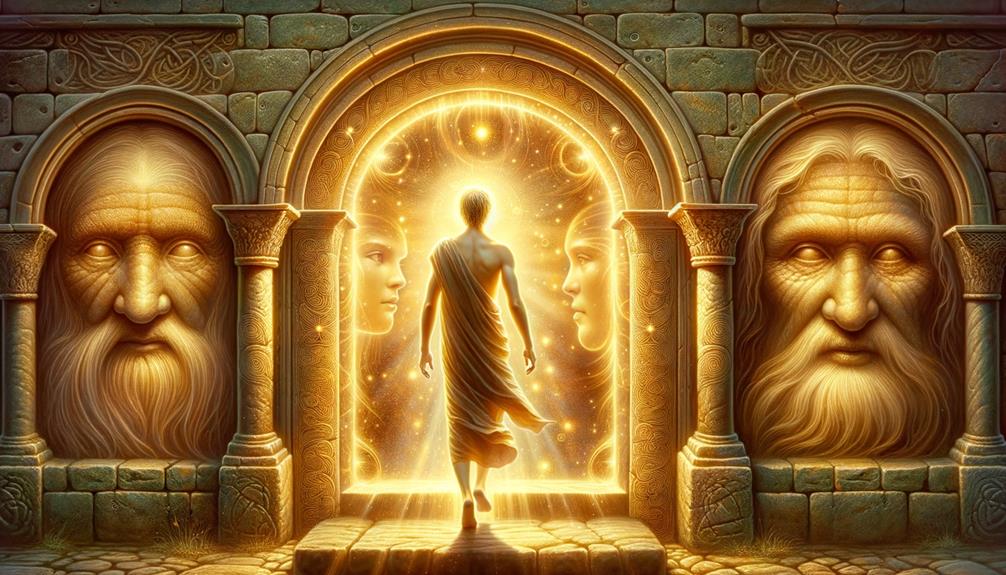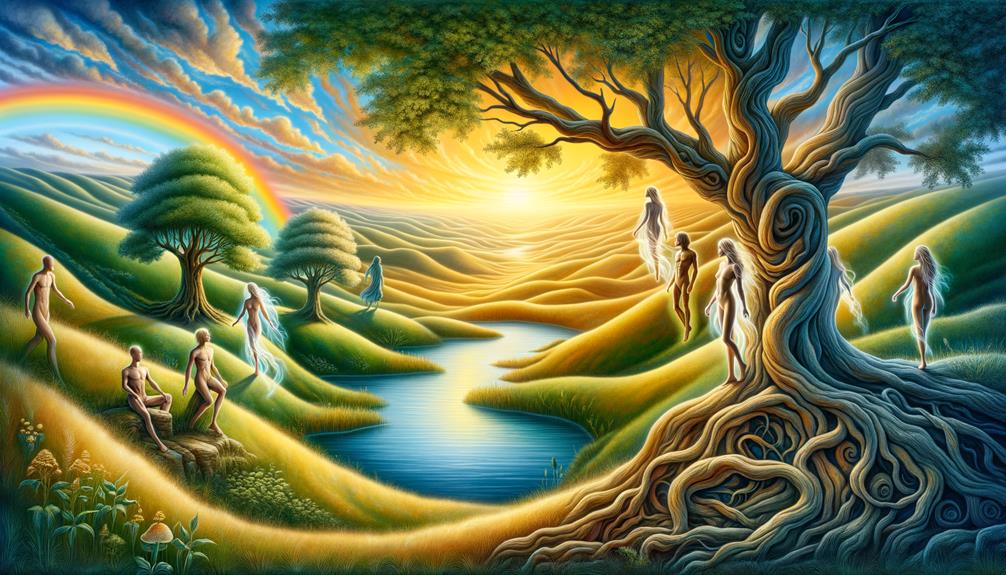I often find myself lost in thought about the credibility of the Irish fairy tale, Tír na nÓg, also known as the Land of Youth, which tells the story of Oisín's adventure into a world of endless youth and joy. This old story, rich with symbolic meanings and cultural references, brings up an interesting contradiction between human desires for eternal life and the inescapable truth of death. As I delve into the depths of this captivating myth, I'm filled with a maze of questions. Why do we, as humans, crave everlasting life? What does the sad ending of the story tell us about our own views on time and growing old? And most importantly, what does this tale mean for our grasp of Irish Celtic mythology as a whole? So, come with me on this fascinating trip as we decipher the symbolic subtext, cultural influences, and deep-seated human wishes contained within the fantasy tale of Tír na nÓg.
Origins of Tir Na Nóg Myth

The tale of Tir Na Nóg originates from traditional Irish folklore and mythology. The name is typically translated as the 'land of everlasting youth'. Tir Na nÓg is envisioned as a magical paradise and mystical dimension, which holds a crucial position in Irish tales.
The legend describes a place of never-ending youth, a Celtic Otherworld, where the Tuatha Dé Danann, the deities of Ireland before Christianity, sought refuge after their loss to the Milesians. Tir Na nÓg is portrayed as an island haven, free from disease or death, where joy is endless, and food is always abundant.
The accounts of Tir Na nÓg offer a peek into how the Irish view the afterlife and their longing for perpetual youth. They echo the Celtic fascination with immortality, a motif prevalent in many Irish tales. Essentially, Tir Na nÓg stands as an embodiment of an ideal life, a paradise beyond the monotony and struggles of human existence.
Unveiling the Story of Oisín

Let's take a journey through the tale of Oisín, a noble warrior who fell under the spell of love and the prospect of unending youth, venturing to the enchanting land of Tír Na nÓg. Oisín, born from the legendary chief of the Fianna, was hopelessly drawn to Niamh, an enchanting lady from this wonder-filled place. Overwhelmed by her charm, he bid goodbye to Ireland and his companions for a lifetime of happiness and youth.
In Tír Na nÓg, Oisín immersed himself in limitless joy, yet he found himself missing his home. After what felt like three years, he made the decision to go back to Ireland. This is where the tale takes a sorrowful twist. Upon his return, the years he was away suddenly caught up with him, turning him from a lively young man to a frail old man. This abrupt aging resulted in his death, highlighting the stark difference between human mortality and the perpetual youth of Tír Na nÓg.
The legend of Oisín is more than just a tale of love and yearning, it also highlights the deceptive nature of timelessness and the unavoidable passage of time. It's a valued piece of Irish folklore, a magical story that continues to spark imagination and delight.
Symbolism in Tir Na Nóg

Let's embark on an exciting journey into the enchanting Irish legend of Tír Na nÓg. Known as the Land of Youth, this legendary place in Irish folklore is more than just a place of eternal youth, beauty, and joy. It's a reflection of our deepest desires for a never-ending paradise.
Take, for instance, the story of Oisín and Niamh's trip to Tír Na Nog. They travel on a magical white horse, a story that brings to life our shared human dream for perfection and everlasting contentment. Oisín, a notable warrior and son of the famous Fionn Mac Cumhaill, is drawn towards Niamh's stunning looks and the allure of an endless life.
Yet, their happiness isn't forever. The three centuries spent in Tír Na nÓg are a representation of how time can distort when we yearn for something. Oisín's ill-fated return to Tír Na and his subsequent swift aging and death after setting foot on Irish soil is a stark reminder of the fleeting nature of beauty and joy. It draws a vivid contrast between the mortal world and the symbolic meaning of Tír Na nÓg.
Cultural Impact and Interpretations

Throughout history, the legend of Tír Na nÓg has woven itself into the heart of Irish culture. Not just a well-known tale passed from one generation to the next, it's also a symbolic testament to the concepts of endless youth and joy. The story of Tír Na, or the Land of Youth, is a cornerstone of Ireland's cultural narrative.
The tale of Oisín, the celebrated Irish hero, and his travels with Niamh to the king of Tír na, captivates listeners to this day. The story of Oisín's time in Tír Na nÓg has left its mark on many facets of Irish culture, spanning literature, music, and even television.
Here are a few examples:
In literature, we have William Butler Yeats's 'The Wanderings of Oisin'. In the world of music, Van Morrison's 'Tir Na Nog' is a standout. On television, 'Mystic Knights of Tir Na Nog' is a prime example. And again in literature, the 'Discworld' series by Terry Pratchett makes a notable reference.
These nods to the Tír Na nÓg myth reveal how deeply this legend of eternal youth has influenced Irish culture. It's a testament to the story's lasting power and relevance, not just in Irish folklore, but far beyond as well.
Decoding the Desire for Immortality

Let's dig a little deeper into our fascination with immortality, shall we? A great reference point for this is 'Decoding the Desire for Immortality', a thorough look into our yearning for eternal life. This desire is beautifully showcased in the myth of Tir Na Nóg, also known as the Land of Youth. Picture Oisín, spending three hundred years in bliss in Tir Na Nóg, only to return to Ireland, age instantly, and die.
So, what makes us yearn for immortality? Here's what we can look at:
- The mental aspect:
- Our fear of death and what lies beyond can make us long for a place akin to Tir Na Nog.
- The cultural and historical angle:
- Ancient burial rituals often depict a journey to a never-ending world. This idea reinforces the concept of Tir Na Nóg.
This myth perfectly encapsulates our longing for a life without death. Oisín's story is a touching illustration of this. The sudden death of Oisín after his return highlights the transient nature of life on earth, contrasted with the eternal youth promised in the Land of Youth. 'Decoding the Desire for Immortality' provides a deeper insight into this enduring human fascination and its far-reaching consequences.
Frequently Asked Questions
What Is the Myth of Tír Na Nóg?
So, let's chat about Tír Na nÓg. This place, straight out of Irish folklore, is a kind of magical spot where no one ages and happiness never ends. Picture a guy named Oisín, right? He gets enticed by a woman named Niamh and ends up in this never-ending party. The whole tale is a poignant reminder of how short and precious life really is.
What Is the Story of Tiernan Og?
Sorry for any confusion, but I don't have knowledge about 'Tiernan Og'. It's possible there might be some confusion with 'Tir Na Nog', a fabled place in Irish folklore known for its eternal youth. However, lacking the necessary context, I can't offer a comprehensive tale.
What Is the Land of Tearnanog?
Have you ever heard about Tír na nÓg? If you haven't, let's chat about it – it's this fantastic place from Irish folklore, often interpreted as the 'Land of Youth.' Imagine a world overflowing with perpetual youth, beauty, and happiness, where people are forever young and sadness is a foreign concept. Sounds pretty neat, eh?
What Is the Story of the Children of Lir?
The tale of the Children of Lir is indeed a sorrowful one. Driven by envy, Aoife transformed them into swans, in which form they remained for a staggering 900 years. Throughout this time, their lovely songs offered a sense of comfort. The spell was broken when the ringing of a Christian bell resonated through the air, but their lives ended soon after, having aged as humans.

